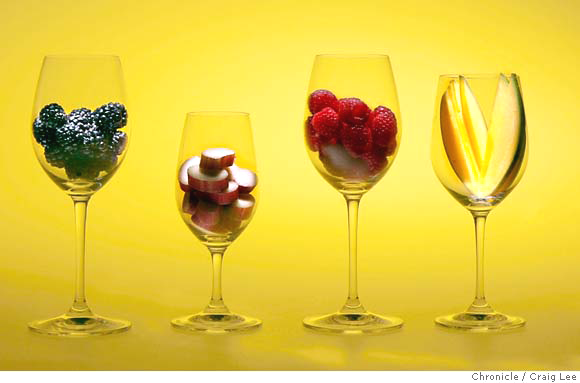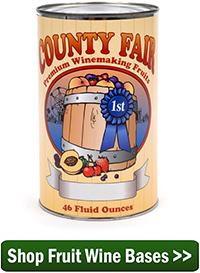 We did a Chardonnay wine kit recently. The results were very good, by all accounts. What is your position on mixing peach, apricot or even persimmon into a batch of that? Wondering. Thanks in advance for your time.
We did a Chardonnay wine kit recently. The results were very good, by all accounts. What is your position on mixing peach, apricot or even persimmon into a batch of that? Wondering. Thanks in advance for your time.
Jeff
—–
Hello Jeff,
Adding fruit to wine kits is a great way to enhance any attractive characteristics that a particular grape may possess. For example: raspberries with Merlot grapes, strawberries with Zinfandel, pears with Pinot Grigio… The options are endless and there is always room for experimentation. It’s a great way to have even more fun while making these wines.
Usually when a home winemaker wants to make a wine in this style, they will mix the wine kit and fruits together in the fermenter and proceed with the fermentation from there. After the primary fermentation has completed, the fruit is then removed as the wine goes into a secondary fermenter. However there is another – more professional – way for adding fruit to wine kits. One that will give you much better control over the end product. In other words, less chance of messing up.
Instead of mixing the grape concentrate and fruit together at the beginning of fermentation, make the chosen fruit into its own wine, separately.
In the case of your Chardonnay, you could make some peach wine – one or two gallons of it. When it is time to bottle, you can experiment with blending some or all of the peach wine with it. 
How much peach flavor you add is a matter of personal taste. You can add a little or a lot. You could do sample taste-testings with varying ratios of the two wines. This is the real power of making the two wines separately. You have complete control over the outcome. If you had added some fruit like peaches at the beginning of fermentation, all you could do is guess as to how much peach to add and hope for the best.
By adding fruit to wine kits in this way, you will have total control over how much fruit flavor is in the wine. This method will also allow you to safely mix blending samples together without risking your entire batch.
We have more information about blending wines together in an article on our website that you may want to take a look at: Blending To Improve Homemade Wines. This article should give you some better insights as to what you are look for when putting two wines together.
As far as whether to try peach, apricot or persimmon, all I can say is that I have seen the most success using peach verses apricot and I have never tasted persimmon added to a Chardonnay. But having said this, I would never tell you not to try any combination. There are no wrong answer when adding fruit to wine kits. Home wine making is about being creative, experimenting and seeing what you can come up.
I would never tell you not to try any combination. There are no wrong answer when adding fruit to wine kits. Home wine making is about being creative, experimenting and seeing what you can come up.
Happy Wine Making,
Ed Kraus
—–
Ed Kraus is a 3rd generation home brewer/winemaker and has been an owner of E. C. Kraus since 1999. He has been helping individuals make better wine and beer for over 25 years.

I think that is awesome that they are now starting to add fruit to wine making kits! My wife and I purchased a wine making kits a few months ago, and our wine turned out pretty well. But, we had to buy our own fruit, so that made it a longer process. So if they started putting fruit in the kits, I am sure that it would be super beneficial to a lot of people.
the companies arent adding fruit, you go and buy it yourself. “People” refers to the winemaker themselves
Whenever I make wine / hard cider from scratch and after following the instructions from a recipe book my end result is a very unpalatable batch that taste nothing like the fruit that I started with. What am I doing wrong?
Tom, you are not doing anything wrong. When the fermentation process completes the wine is dry, meaning all of the sugar is gone. One of the effects that dryness has on a wine is that it reduces the fruity impression of the wine. When all the sugars have been fermented out of the fruit juice it takes on an entirely different character. Back sweetening the wine can help bring back the fruity flavors. Below you will find the links to a couple of articles that will discuss this topic in more detail.
Increasing Fruit Flavors
https://blog.eckraus.com/increasing-your-wines-fruity-flavors
My husband and I love experimenting with different flavors…especially peppers. We have made several “spicy wines”. Blackberry and green chili, habanero raspberry (the favorite of our friends so far), Pineapple jalapeno. We have a blackberry and ghost pepper going right now. We make the fruit wine and pepper wines separate. Once we are ready to bottle is when we begin the blending process. We usually have left over pepper wine. We bottle it and use it in our cooking. We like to use them in our spaghetti sauces, chili’s, put a shot of it in a beer or other beverage…and some of our friends just love the straight pepper wines. There really are not a lot of recipes for pepper wines. We like to use the recipe in the link below, and we just play around with the amount of peppers. We also add dried fruits for balance such as dried apricots and raisins.
http://winemaking.jackkeller.net/reques32.asp
I am going to make a California Merlot and would like to add some blueberries. My question is would 6 to 8 oz. of berries be enough, don’t want an overpowering berry taste and should they be added at the first fermentation step.
The amount you are suggesting sounds reasonable if you are just looking to give a not of blueberry to the wine, but I can only guess. You can add the same mount to two different fermentations and have different results. If at all possible, a better approach would be to make some blueberry wine. And when both wines are finished and ready to bottle, blend to taste. This gives you complete control over the results.